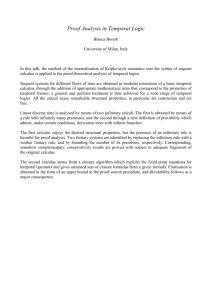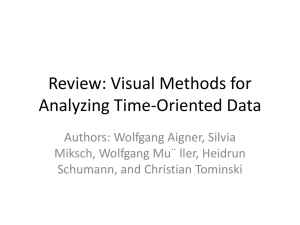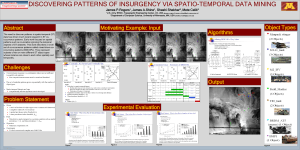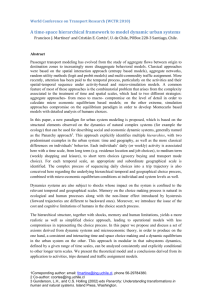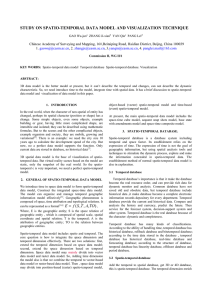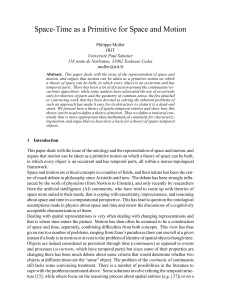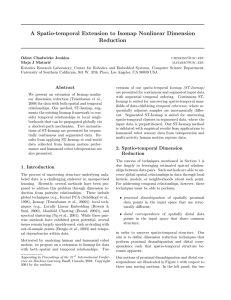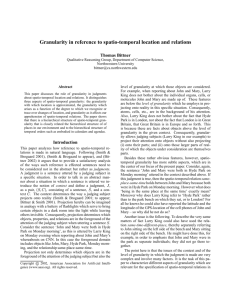Abstract
advertisement
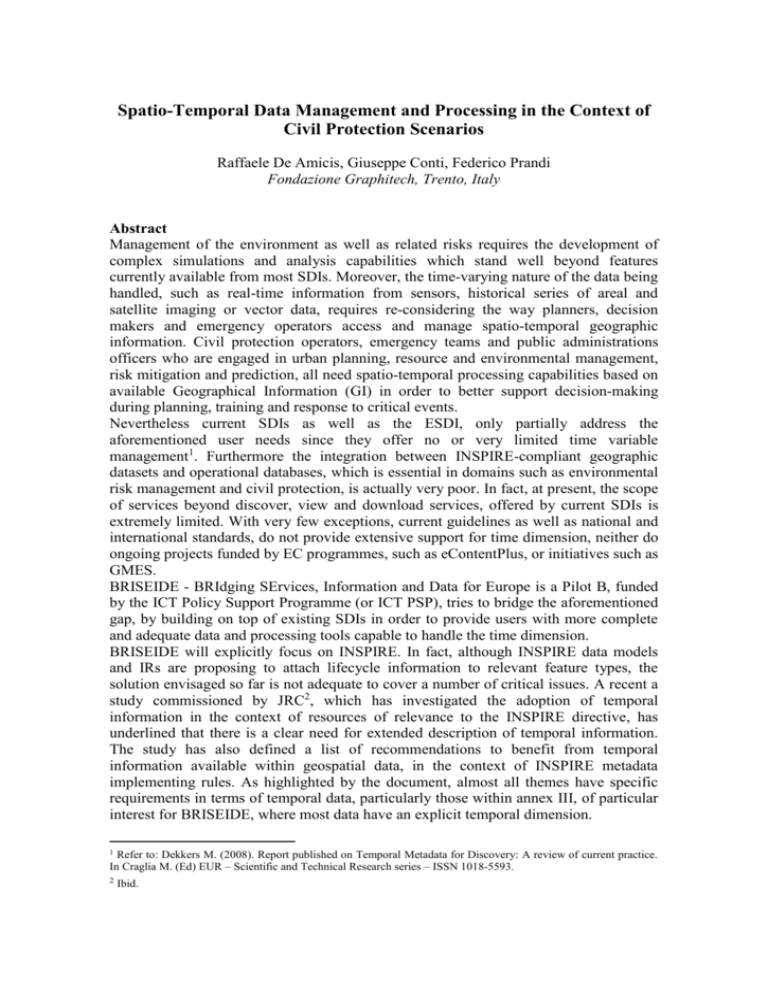
Spatio-Temporal Data Management and Processing in the Context of Civil Protection Scenarios Raffaele De Amicis, Giuseppe Conti, Federico Prandi Fondazione Graphitech, Trento, Italy Abstract Management of the environment as well as related risks requires the development of complex simulations and analysis capabilities which stand well beyond features currently available from most SDIs. Moreover, the time-varying nature of the data being handled, such as real-time information from sensors, historical series of areal and satellite imaging or vector data, requires re-considering the way planners, decision makers and emergency operators access and manage spatio-temporal geographic information. Civil protection operators, emergency teams and public administrations officers who are engaged in urban planning, resource and environmental management, risk mitigation and prediction, all need spatio-temporal processing capabilities based on available Geographical Information (GI) in order to better support decision-making during planning, training and response to critical events. Nevertheless current SDIs as well as the ESDI, only partially address the aforementioned user needs since they offer no or very limited time variable management1. Furthermore the integration between INSPIRE-compliant geographic datasets and operational databases, which is essential in domains such as environmental risk management and civil protection, is actually very poor. In fact, at present, the scope of services beyond discover, view and download services, offered by current SDIs is extremely limited. With very few exceptions, current guidelines as well as national and international standards, do not provide extensive support for time dimension, neither do ongoing projects funded by EC programmes, such as eContentPlus, or initiatives such as GMES. BRISEIDE - BRIdging SErvices, Information and Data for Europe is a Pilot B, funded by the ICT Policy Support Programme (or ICT PSP), tries to bridge the aforementioned gap, by building on top of existing SDIs in order to provide users with more complete and adequate data and processing tools capable to handle the time dimension. BRISEIDE will explicitly focus on INSPIRE. In fact, although INSPIRE data models and IRs are proposing to attach lifecycle information to relevant feature types, the solution envisaged so far is not adequate to cover a number of critical issues. A recent a study commissioned by JRC2, which has investigated the adoption of temporal information in the context of resources of relevance to the INSPIRE directive, has underlined that there is a clear need for extended description of temporal information. The study has also defined a list of recommendations to benefit from temporal information available within geospatial data, in the context of INSPIRE metadata implementing rules. As highlighted by the document, almost all themes have specific requirements in terms of temporal data, particularly those within annex III, of particular interest for BRISEIDE, where most data have an explicit temporal dimension. 1 Refer to: Dekkers M. (2008). Report published on Temporal Metadata for Discovery: A review of current practice. In Craglia M. (Ed) EUR – Scientific and Technical Research series – ISSN 1018-5593. 2 Ibid. Furthermore a report from the EC3 on the status of INSPIRE implementing rules has set, as priority for the Drafting Team, the need “to express different temporal dimensions of data in different thematic communities” clearly acknowledging that “different thematic communities have different ways to express the temporal dimensions of their datasets […] It is appropriate that such matters are considered by the working groups that will address the interoperability of spatial datasets and services for the relevant themes in Annexes II and III”. More specifically, in current IRs, only four temporal elements are considered. These are within the metadata element “temporal reference” which includes the following subelements: 1. The temporal extent of the resource (the time period covered by the resource). 2. The resource’s date of creation. 3. The resource’s date of publication. 4. The resource’s date of last revision This information is complemented by an additional piece of information related to element metadata date which defines the date when the metadata was created or updated. However this information is related to the resource’s lifecycle with no direct reference on temporal information on the real phenomenon, with only element “temporal extent” being partially related to information on the real resource. In fact, although it is possible to describe the event within the “resource abstract”, with the current model it is not possible to provide a temporal characterization of the phenomenon. For instance, in the case of different satellite imagery showing forest fires, the present models allow defining the time when the image showing the fire was taken but not the actual time at the fire took place. It is evident that this piece of information is extremely important to be able to retrieve information on the evolution of the fire at different time intervals. For this reason BRISEIDE proposes to extend current data/metadata models to be able to benefit from information available at high refresh rate (e.g. from sensors) as well as to be able to analyze evolution of phenomena over time. To do so BRISEIDE will: 1. Deliver time-aware extensions of data models developed in the context of previous/ongoing INSPIRE-related projects, including, but not limited to, a number of eContentPlus projects such as NatureSDIPlus, EURADIN, etc. 2. Develop a number of value added services for spatio-temporal data management, authoring, processing, analysis and interactive visualisation. 3. Deploy a number of 3D web-based pilot applications based on the integration of existing, user operational information. The pilots B will be deployed, tested and validated within a number of different scenarios, across several EU countries related to Civil Protection application context, by building on top of relevant INSPIRE themes, via a chain of stakeholders, data providers, technology partners, and downstream users. The operational phase of BRISEIDE will last twelve months and will consider real life events, with extensions in additional domains, being considered and assessed. Since BRISEIDE applications and validation will focus on the INSPIRE Directive the services developed will use existing pan-European datasets made available by Public 3 European Commission (2008). INSPIRE metadata implementing rules: summary of process. Date of last revision: 2008-04-28 Administrations, including Regional governments and public administration departments as well as those datasets available through a number of INSPIRE-related EU projects through specific which have formally signed a Memorandum of Understanding with the project. This way the different pilots will provide coverage of the vast majority of EU countries. However BRISEIDE services will not be not strictly dependant on a specific dataset and therefore it will be possible to deploy or extend them to other application domains. From a technical standpoint, BRISEIDE develops spatial analysis through Web Processing Services (WPS) and integrates them within existing open source WPS framework such as Sextante by 52°North and PyWPS by HS-RS. Spatio-temporal processing services will be exposed via the web and made available through compatible WebGIS applications. BRISEIDE will also take advantage from newly developed as well as prototypical OWSs already made available by relevant INSPIRE-related EU projects that expose standard services such as WMS, WCS and WFS. These will be used to provide access to relevant geodatabases, enriched, when needed, with information, extracted from heterogeneous, distributed user operational databases. At the client level BRISEIDE services will be accessible through a multi-platform 3D client, invoked from a webpage as a Java WebStart application. The 3D client allows interactive orchestration of spatio-temporal WPSs providing support to chaining of required processing units. This ensures interactive access to datasets and asynchronous processing at the server side. In a typical scenario an operator logs onto a webpage and activates a 3D web-based client. A number of spatio-temporal processing services exposed by distributed servers are made available through its graphical user interface in a very interactive and user friendly manner. The functionalities available as WPS (Web Processing Service) allow application oriented (e.g. Civil Protection) processing, navigation and query of time series. The user drags and drops processing units within the 3D environment and connects them, thus creating complex compound spatio-temporal chains. The system then automatically orchestrates the different processes involved and it invokes them in the proper order. The results of the analysis are interactively shown on the screen. All BRISEIDE processing services will be available through other OGC-compliant webGIS applications (e.g., GvSIG). Most relevantly the spatio-temporal services of BRISEIDE will be available as open source.

